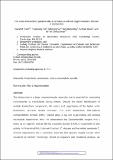| dc.contributor.author | Kern, David Matthew | |
| dc.contributor.author | Kim, Taekyung | |
| dc.contributor.author | Rigney, Mike | |
| dc.contributor.author | Hattersley, Neil | |
| dc.contributor.author | Desai, Arshad | |
| dc.contributor.author | Cheeseman, Iain M | |
| dc.date.accessioned | 2015-01-05T18:00:57Z | |
| dc.date.available | 2015-01-05T18:00:57Z | |
| dc.date.issued | 2014-11 | |
| dc.date.submitted | 2014-11 | |
| dc.identifier.issn | 1059-1524 | |
| dc.identifier.issn | 1939-4586 | |
| dc.identifier.uri | http://hdl.handle.net/1721.1/92587 | |
| dc.description.abstract | The kinetochore is a large, macromolecular assembly that is essential for connecting chromosomes to microtubules during mitosis. Despite the recent identification of multiple kinetochore components, the nature and organization of the higher order kinetochore structure remain unknown. The outer kinetochore KNL-1/Mis12 complex/Ndc80 complex (KMN) network plays a key role in generating and sensing microtubule attachments. Here, we demonstrate that Caenorhabditis elegans KNL-1 exists as an oligomer and we identify a specific domain in KNL-1 responsible for this activity. An N-terminal KNL-1 domain from both C. elegans and the related nematode C. remanei oligomerizes into a decameric assembly that appears roughly circular when visualized by electron microscopy. Based on sequence and mutational analysis, we identify a small hydrophobic region as responsible for this oligomerization activity. However, mutants that precisely disrupt KNL-1 oligomerization did not alter KNL-1 localization or result in the loss of embryonic viability based on gene replacements in C. elegans. In C. elegans, KNL-1 oligomerization may coordinate with other kinetochore activities to ensure the proper organization, function, and sensory capabilities of the kinetochore-microtubule attachment. | en_US |
| dc.description.sponsorship | Leukemia & Lymphoma Society of America (Scholar Award) | en_US |
| dc.description.sponsorship | National Institute of General Medical Sciences (U.S.) (Grant GM088313) | en_US |
| dc.description.sponsorship | American Cancer Society (Research Scholar Grant 121776) | en_US |
| dc.language.iso | en_US | |
| dc.publisher | American Society for Cell Biology | en_US |
| dc.relation.isversionof | http://dx.doi.org/10.1091/mbc.E14-06-1125 | en_US |
| dc.rights | Creative Commons Attribution | en_US |
| dc.rights.uri | http://creativecommons.org/licenses/by-nc-sa/3.0/ | en_US |
| dc.source | American Society for Cell Biology | en_US |
| dc.title | The outer kinetochore protein KNL-1 contains a defined oligomerization domain in nematodes | en_US |
| dc.type | Article | en_US |
| dc.identifier.citation | Kern, David M., Taekyung Kim, Mike Rigney, Neil Hattersley, Arshad Desai, and Iain M. Cheeseman. “The Outer Kinetochore Protein KNL-1 Contains a Defined Oligomerization Domain in Nematodes.” Molecular Biology of the Cell (November 19, 2014). | en_US |
| dc.contributor.department | Massachusetts Institute of Technology. Department of Biology | en_US |
| dc.contributor.department | Whitehead Institute for Biomedical Research | en_US |
| dc.contributor.mitauthor | Kern, David Matthew | en_US |
| dc.contributor.mitauthor | Cheeseman, Iain McPherson | en_US |
| dc.relation.journal | Molecular Biology of the Cell | en_US |
| dc.eprint.version | Final published version | en_US |
| dc.type.uri | http://purl.org/eprint/type/JournalArticle | en_US |
| eprint.status | http://purl.org/eprint/status/PeerReviewed | en_US |
| dspace.orderedauthors | Kern, David M.; Kim, Taekyung; Rigney, Mike; Hattersley, Neil; Desai, Arshad; Cheeseman, Iain M. | en_US |
| dc.identifier.orcid | https://orcid.org/0000-0002-3829-5612 | |
| dc.identifier.orcid | https://orcid.org/0000-0001-8529-9045 | |
| mit.license | PUBLISHER_CC | en_US |
| mit.metadata.status | Complete | |
